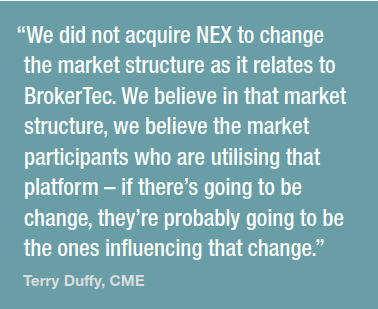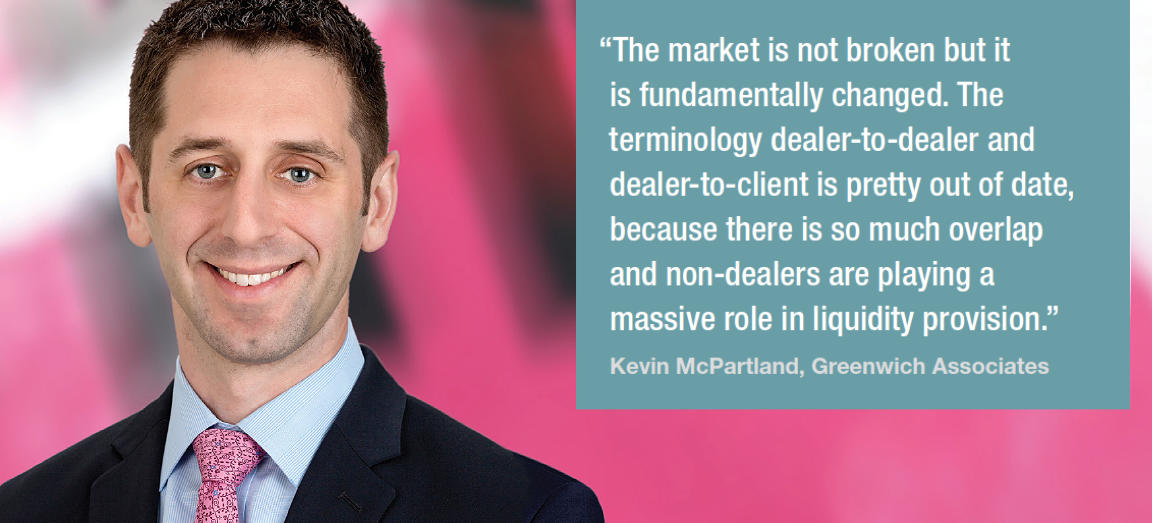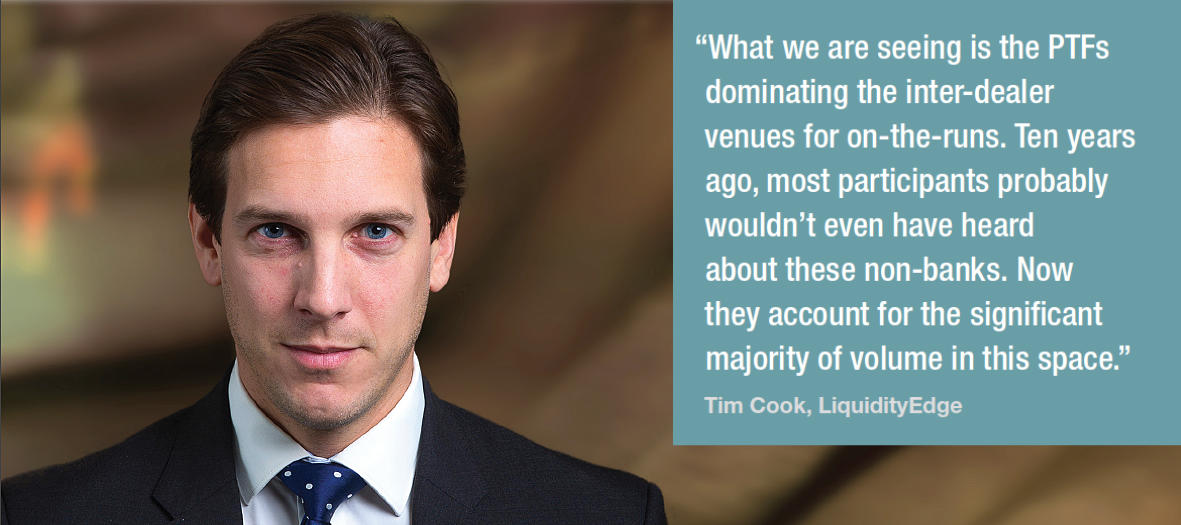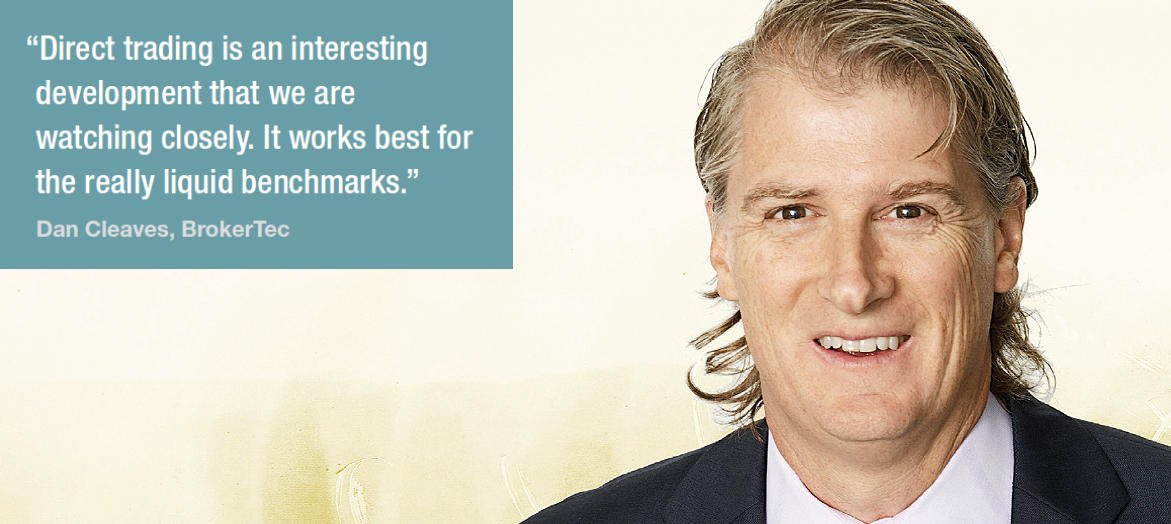Proprietary trading firms are driving change faster than the interdealer brokers, writes David Wigan.
Direct streaming of pricing data is changing the historical client/dealer relationship for traditional sell-side firms and the buy side, but it is proprietary trading firms (PTFs) and not market operators who are changing buy-side access.
The CME, which acquired BrokerTec, the largest US Treasury market central limit order book (CLOB) via its acquisition of NEX Group in 2018, has said it will migrate BrokerTec onto the CME’s Globex trading platform in 2020, but will retain the current operating model.
 Terry Duffy, CEO of the CME, said on an earnings call in Q4 2018, “We did not acquire NEX to change the market structure as it relates to BrokerTec. We believe in that market structure, we believe the market participants who are utilising that platform – which are the largest banks and biggest platforms – if there’s going to be change, they’re probably going to be the ones influencing that change.”
Terry Duffy, CEO of the CME, said on an earnings call in Q4 2018, “We did not acquire NEX to change the market structure as it relates to BrokerTec. We believe in that market structure, we believe the market participants who are utilising that platform – which are the largest banks and biggest platforms – if there’s going to be change, they’re probably going to be the ones influencing that change.”
The impact of regulation on the cost of holding inventory has prompted primary dealers in the US Treasury market to de-risk. Many have left the market completely – reducing the total from around 46 in the late 1980s to 23 in early 2019. Just five of those are estimated to be responsible for at least 60% of dealer-to-client trades. In the dealer-to-dealer market, a new breed of players, less burdened by regulatory and capital requirements, has stolen a march. These PTFs include Citadel, Teza Technologies, XR Trading, DRW, and Jump Trading, the market leader by reported volume, according to sources.
PTFs have catalysed a step change in the treasury markets, employing high-frequency algorithms to offer razor-thin spreads that banks find it hard to justify. In a market that trades mainly on price, they have managed to grab significant share. The shift came to the attention of regulators in October 2014, when a so-called “flash rally” saw 10 -year treasury yields tighten 16 basis points in 12 minutes, and then rebound. The five standard deviations move is theoretically a once in five-thousand-year event. It prompted the first government review of the treasury market in 20 years.
Amid concern the market “was broken”, a subsequent report found that dealers accounted for just 34 percent to 44 percent of volume on specific control days, depending on the maturity of the security. PTFs accounted for 51 percent to 57 percent.
D2C and D2D is old news
“The market is not broken but it is fundamentally changed,” says Kevin McPartland, head of market structure and technology research at Greenwich Associates. “The terminology dealer-to-dealer and dealer-to-client is pretty out of date, because there is so much overlap and non-dealers are playing a massive role in liquidity provision.”

The US Treasury securities market is the largest and most liquid sovereign bond market in the world, with US$14 trillion outstanding and average daily trading volume of around US$575 billion, according to TRACE data. It is split about equally between dealer-to-dealer (via interdealer broker) and dealer-to-client activity. Roughly 70 percent of IDB volume occurs on electronic and automated platforms and 30 percent on voice and manual screen.
Most PTFs do not submit TRACE reports, but it is possible to approximate PTF activity from reported non-dealer activity. On that basis PTFs account for about 62 percent of electronic/automated interdealer broker trading volume, while primary dealers and other dealers account for about 78 percent of voice/manual screen broker volume. In other words, where trading is electronic, PTFs dominate. According to the estimate of one industry insider, Jump Trading alone is on one side of 30% of CLOB trades.
In the dealer-to-client segment, dealers are still in charge, and in fact dealers now play a much more significant role than they do in the interdealer market, participating on one side of nearly all trades.
The long-term venues of choice for interdealer/PTF trading are BrokerTec and Nasdaq. BrokerTec is the market leader, accounting for around $200 billion of daily business. Nasdaq does about a third of that.
As PTFs have taken control of the interdealer market a parallel battle has played out between trading venues, which have attempted to align their strategies with market participants’ changing behaviours. However, the moves have had limited success. Probably the most salutary lesson was provided by ESpeed, sold by Cantor Fitzgerald to Nasdaq in 2013. Soon after the acquisition, Nasdaq CEO Bob Greifeld promised to expand ESpeed’s customer base through all-to-all trading. The dealer community did not like it, and over the following few years Nasdaq’s market share plummeted.
“The big D2D venues have traditionally trod very lightly when it comes to opening up and its pretty easy to see why after what happened to ESpeed,” said McPartland. BrokerTec has invited some large hedge funds onto its platform, but they are the exception rather than the rule.
Direct liquidity
The traditional bifurcated model remains dominant. However, there are signs of change, central to which is the emergence of so-called direct streaming. Direct streaming combines traditional D2D central limit order books with one-to-one contact and confidentiality. Its emergence may be seen as the natural result of the dynamic of the past few years, in which PTFs have laid siege to D2D, but have gained little traction in D2C. As early as 2013 this prompted firms such as Getco and Citadel to set up direct relationship with clients. Banks including Barclays, Goldman Sachs, Citi and Credit Suisse were quick to follow suit.
Those experiments produced limited success, largely because of the cost of integrating new platforms with individual customers. However, the idea stuck and in 2015 LiquidityEdge, founded by former ICAP exec David Rutter, launched a new concept based on aggregating direct-to-customer streams through a single point of entry. The platform provides bilateral streaming on a fully-disclosed basis or anonymous trading facilitated by a disclosed counterparty. The fact that participants do not have to actively ask for a price means they can browse the market anonymously. PTFs, which were increasingly trading against each other on CLOBs, were happy to jump on board, perhaps seeing the bilateral model as a potential way in to the D2C market.
In truth, the vast majority of traffic in direct streaming is on-the-run dealer-to-dealer. However, the direct model has sparked something of a price war. LiquidityEdge cut tick sizes to 1/8th of a 32nd (from the dominant ¼ level) and now, after that was matched by the big venues (on two-year notes), to 1/16th of a 32nd on two- and three-year tenors.

“What we are seeing is the PTFs dominating the inter-dealer venues for on-the-runs,” said Tim Cook, head of EMEA sales at LiquidityEdge. “Ten years ago, most participants probably wouldn’t even have heard about these non-banks. Now they account for the significant majority of volume in this space.”
The holy grail of buy-side participation, however, remains an aspiration. Buy-side players account for less than 5% of trades on both streams and CLOBs, according to Greenwich data. One reason is the complexity of integrating buy-side order management systems such as those provided by ION and Charles River.
“These are heavy duty bits of kit,” said Cook. “We need to support our clients to use these systems and to get the integration work done, and we are making a lot of progress down that path.”
A further challenge is that direct streaming does not lend itself to off-the-run tenors, although LiquidityEdge does offer some off-the-run trading. This again may be seen as a disincentive to the buy side, which is accustomed to trading off-the-run through dealers and usually on the phone. For the moment, the dominant D2D venues are sanguine.

“Direct trading is an interesting development that we are watching closely,” says Dan Cleaves, CEO of BrokerTec. “It works best for the really liquid benchmarks. Still, we are keen to provide as many trading options as possible to our clients, and we’re giving BrokerTec Direct a makeover so that we can address that quite small segment of the market.”
Trading via direct streams currently accounts for 8% of the total market volume, or roughly $40 billion daily, according to Greenwich.
Clearing reform
Another impediment to transformative change is the clearing framework, which is bifurcated into dealer clearing through Fixed Income Clearing Corp (FICC) and a patchwork of alternative arrangements for everybody else. At least one new direct streaming platform has failed because it did not manage to put practical clearing arrangements in place. For CME/BrokerTec and Nasdaq the FICC connection is a competitive advantage. CME has yet to say whether it will try to integrate BrokerTec into its own clearing franchise. The Treasury Market Practices Group (TMPG), a committee of buy and sell-side firms and trading platforms, meanwhile, has launched a consultation around the clearing issue. It has yet to opine on solutions.
For the moment, and despite the inroads made by direct streams, the status quo remains fairly secure. Certainly, for the big two there is little sense that the shifting ground threatens transformative disruption, and amid rising Treasury volatility both have reported brisk business in recent months.
“Nasdaq has re-platformed our US Treasury offering and we will continue to focus on the needs of our clients,” said a spokesman for the company. “The interdealer market is ripe for change but just because something is built doesn’t mean the banks will use it.”
©The DESK 2019
©Markets Media Europe 2025












